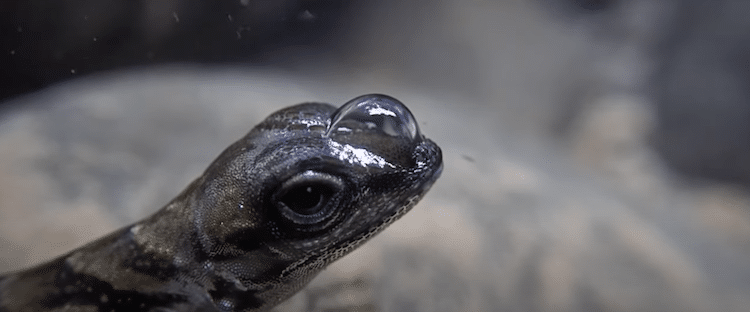
Nature is always evolving in fascinating ways, and one lizard from the tropical rainforests of southwestern Costa Rica and Panama is a perfect example of that. Anolis aquaticus, better known as the water anole, is a semi-aquatic lizard with a remarkable survival trick. Often called “scuba-diving lizards,” they’ve developed the ability to create an air bubble over their heads, allowing them to breathe while underwater.
These small lizards—with a length of about 6 to 8 inches—are a favorite snack for many predators, including birds and snakes. When threatened, they often dive underwater and form a bubble over their nostrils using their skin, allowing them to draw in oxygen while submerged.
Lindsey Swierk, an assistant research professor of biological sciences at Binghamton University, wanted to learn if this bubble really helped water anoles stay underwater for longer, compared to lizards without a bubble.
She carried out an experiment where she applied a substance to the lizards’ skin to stop them from forming bubbles. “Lizard skin is hydrophobic,” Swierk explains. “Typically, that allows air to stick very tightly to the skin and permits this bubble to form. But when you cover the skin with an emollient, air no longer sticks to the skin surface, so the bubbles can’t form.”
The research revealed that lizards in the control group, which weren’t exposed to the emollient, were able to remain underwater 32% longer than those without an air bubble. “This is really significant because this is the first experiment that truly shows adaptive significance of bubbles,” says Swierk. “Rebreathing bubbles allow lizards to stay underwater longer. Before, we suspected it—we saw a pattern—but we didn’t actually test if it served a functional role.”
Thanks to their life-saving bubble, water anoles can stay underwater for 20 minutes or longer, allowing them to escape predators and stay safely camouflaged until the danger passes.
Swierk’s fascinating findings have led other researchers to look into the water anole and its clever survival mechanism. Some hypothesize that the bubble is actually a gill, and others are wondering if this bubble-breathing adaptation is also common among other lizard species. Either way, studying lizards more closely could help us learn how this amazing survival strategy developed and maybe even reveal other adaptations.
Check out Swierk’s research here.
h/t: [earth.com]
Related Articles:
New Study Reveals Komodo Dragons Have Iron-Capped Teeth
Adorable Lizard Uses Blossoming Rose as a Comfy Bed
The Most Laid Back Dragon Lizard Strums a Song on His Leaf Guitar
